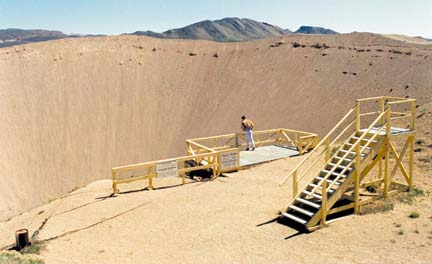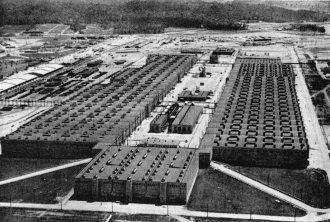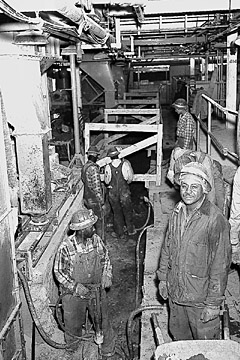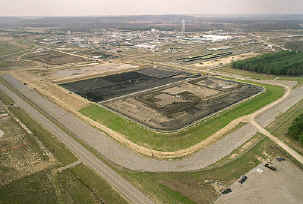
| The U.S. Department of Energy 1991 thru 2000 | 
|
The Sedan Crater at the Nevada Test Site The Department of Energy (DOE), and its predecessor agencies the Energy Research and Development Administration and the Atomic Energy Commission, conducted nuclear tests and other experiments at the Nevada Test Site. Since the establishment of the Nevada Test Site in 1951, thousands of people from around the world -- senior citizens to college students -- have this vast outdoor laboratory that is larger than the state of Rhode Island, to see firsthand, artifacts and archaeological sites from the early settlers, to the many relics remaining from nuclear weapons tests, nuclear rocket experiments, and a variety of other defense, environmental, and energy-related programs.
|
The DOE Office of Environmental Management is responsible for the cleanup of our nations former weapon production facilities. And even though we were the cleanup crew and not the developers of weapons productions, all Department of Energy employees were encouraged to learn about the history of DOE and travel to as many DOE Field Offices as one could bear. DOE definitely provided me a tremendous opportunity to see many parts of the United States. Each location has it's unique history and purpose during the Manhattan Project. During my time I traveled to three weapons facilities in Oak Ridge Tennessee, Fernald Ohio, and the Nevada Test Site near Las Vegas. The pictures below are places I have been to. The most memorable place I ever visited was the Nevada Test site and, in particular, my tour of the Sudan Crater. As you can see from the picture, it is completely dry desert. I was transported by a van out to the Sudan Crater with some other DOE employees that I had never met before (DOE can be like that --everyone is always traveling). Apparently though, a visit to the Nevada Test Site is not complete unless you've seen this crater. There is still some residual radiation from this particular shot because it was not a contained shot in that radioactive gases were released at the time that it was detonated. I was told that there are old videos of the blast that show a person running out to the site immediately after the blast to take a soil sample. At the time that I was there, there were car tires down in the bottom of it which looked like small donuts. The Sedan crater at the Nevada Test Site is nearly a quarter-mile wide and 320 feet deep! I was trying to imagine some good 'ole boys dragging tires out there to watch them roll down the sides of the crater (weird way to spend an afternoon). Especially, since it was supposed to be a secure site and also could provide a dose with extended time hanging around there. I am sure they must have come out there at night. Looking down into the crater it is really awe inspiring because there are no natural geologies that are shaped like the inverse of a mountain on earth. It's perfectly conical....at which point a discussion of earlier proposals to use this 1962 test to investigate whether nuclear weapons for excavating canals such as in Alaska was discussed ...makes some sense (if you could only not have the leftover radiation). The other people in the tour group (myself included) just kind of stood there speechless. It is easier to comprehend the power of atomic weaponry after visiting such a site. But it is never easy to understand how something could be developed that could have THAT much POWER. This experience was quite humbling. I am not sure how it changed me but it definitely haunts me. A saying by The Bhagavad-Gita kind of describes the feelings I had. It goes like this.... If the radiance of a thousand suns were to burst at once into the sky, that would be like the splendor of the Mighty One... I am become Death, The shatterer of all worlds I never saw an actual atomic bomb but the lady who hired me had. She told me that she saw one at the Pantex plant in Texas when she was touring the waste storage areas. When she was walking away from the waste management building with two men, a "bomb" was being wheeled around the corner of an adjacent building. Apparently, the site of seeing this affected her so dramatically that she became light-headed. In order to get the blood back to her head and also not to embarrass herself, she bent down to tie her shoes. It worked for a while but unfortunately, when she got back to the car, she passed out. Knowing this woman, who always was totally unflappable, who was a runner, and a competitor in the largest sense (not to mention someone who kept a lascivious poster of Mel Gibson in the movie series MAD MAX Road Warrior on the back of her office door, I figure it had to be pretty overwhelming if it impacted her that much. |
|
The Oak Ridge Reservation located in Tennessee
The Gaseous Diffusion Plant in Tennessee
Women operating dials in the K-25 Gaseous Diffusion Plant
|
My experience at the Oak Ridge Facility was fairly minimal. I really couldn't figure out Oak Ridge to tell you the truth and I think that is how they liked it. I remember having a contractor call me from there and having him tell me that he could be fired if anyone find out he was talking to me. There is a lot of paranoia there. Oak Ridge does have a wonderful museum in the town that is really worth going to. It covers the town's role in the Manhattan project. The history of Oak Ridge and is involvement is pretty substantial. Oak Ridge had the responsibility for coming up with sufficient amounts of one of two necessary isotopes, uranium-235. It was a $2-billion effort. The strategy for getting to that end was quite desperate. There were three valleys dedicated to two different enrichment processes there. Not knowing which would work better and facing the urgency of war, the government decided to build a plant for each method. Topography around Oak Ridge made it possible to separate the plants from each other -- and from the main laboratory -- by placing them in different valleys so that an accident might be contained. The more successful enrichment process was the gaseous diffusion plant. I had a tour of the inside of this facility. It is an amazingly huge building. My memory is that it is a couple of football fields wide. When it operated it was very hot inside. So much so that the tin along the roof line was black and warped. The electricity requirements for this facility required the equivalent of 3 power plants which because of the TVA, Oak Ridge was a very suitable location for this endeavor. I purchased a book about the history of the facility from the museum and the most memorable photograph is of a long hallway of women sitting on stools looking at dials. I found it to the left. Each woman had to adjust and optimize these dials all day long and never knew what they were making. At the end of the day, a person with a black hood would collect the unknown substance (enriched uranium) which was usually a few tablespoons and vault it. The person's identity in the hood was concealed so that no one knew who to ask. The attitudes and respect for authority that people of that generation maintained is truly interesting because no one ever knew until the bomb was dropped on Hiroshima what their role had been in the war. Apparently, this was truly a city behind a fence, worker's homes were behind the gate and it was designed to be sustainable so that people would not need to leave the gate as much as possible. I think these people are tough and survivors of that era and it has become a part of their heritage. The attitudes toward authority figures has changed though through the years since though. Apparently, the gaseous diffusion plant was shutdown by a person from Washington, D.C. who had repeatedly asked Oak Ridge to turnoff the facility. After being ignored for many months, he finally flew down and pulled the circuit breakers himself. I don't think he was a very popular person that day. There must have been a lot of jobs associated with running that massive building. Oak Ridge still works with uranium in a facility there. I was quite impressed with the security where the uranium was stored. When you enter the facility you have to pass through numerous checkpoints and the last one is a long sealed windowless hallways shaped in a maze as you entered these areas which will hatch down if you try to leave and your badge isn't recognized. Guards change posts using the buddy system and jog to their next post with huge machine guns carried arms out in front of them. If your in the hallway when they jog by, you are invisible to them and you have to move out of their way because they don't move for you. I couldn't imagine anyone taking off with any U-235. |
|
The Fernald Environmental Management Project (FEMP) located in Ohio
Whenever I went to Fernald I felt like I was in a 1950's time warp. When you entered the site the first thing you saw was a red checkered water tower which made you think of a Purina Pet Food Plant. I don't know if that was intentional or not, but all of the DOE plants were intended to be secret facilities. Also, the workers rode around on antique bicycles from building to building. The bikes never left because they are so durable and because no one was allowed to take them outside of the gate because of possible contamination. The workers dress in cotton garb like what nurses wear which are taken off and laundered every day.
Low-level Waste Disposal Cell
K65 Vitrification Pilot Plant
|
The Fernald site is a former uranium metal production facility which involved melting uranium metal in smelters, molding them and then machining them into derbies (which is the shape used to describe the tire-like mold). Ohio was chosen for this operation back in the 1951 because there was a large population of skilled machinists and like a lot of sites because there was a good source of water supply (the Great Miami Aquifer). I was provided a tour of the facility by a former machinist prior to it's shutdown in 1989. This was quite a privilege actually to speak to someone who actually knew the operation. The men loved the "operations" and for them it was "glory days". There had definitely been a loss in mission and purpose and I could definitely envision that he was very much like one of these men in the picture to the left. One of my proudest accomplishments at the Dept.of Energy included approving the Official Record of Decision for the Fernald site Waste Disposal Cell and Great Miami Aquifer Wastewater Treatment Operations. I played a significant role in the current success of that project. For the on-site disposal cell, policy needed to be approved and written to allow the siting of the disposal cell under environmental Superfund review procedures. Without this policy, the site would need to be approved under the Atomic Energy Act disposal standards delaying the project for many years. Having taken the time to review both regulations for disposal, I knew that there would be conflicts in approaches. So I immediately started working with the regulatory experts on the issue. In addition, there were Congressional oversight boards to bring into the loop and to convince that we could meet the nuclear standards under an environmental approach. The final guidance was prepared after many meetings and the decision to take this approach can be found here. The existing wastewater treatment plant which is being used to treat uranium contaminated groundwater was also changed as a result of my prior experience in sizing similar facilities for municipal applications. My extensive review of this facility resulted in a significant redesign from a 8000 gpm facility to a 3000 gpm facility saving as much as $200 million dollars for the Department. The picture to the left is of me standing next to a glass vitrification monitor which is showing the inside of the furnace. Glass vitrification is one of the treatment methods chosen to immobilize highly active radon bearing "K65" uranium ores that were stored in a large silo on the Fernald site. The waste material is encapsulated in a glass bead. The uranium ores were never processed in a gaseous diffusion plant and somehow ended up being transported to Ohio. They originated in the African Congo and apparently men lost their lives settling the area where the ores were mined because it was deep in the jungle with a large population of "man-eating" tigers. These particular ores were so high in radon that they posed one of the largest health risks when compared to other risks from other DOE facilities. People get very anxious with the idea of spent radioactive fuels but you can't inhale the stuff and it can be shielded pretty easily. And while all radioactive materials lasts a long time, people forget that the element Lead (Pb) lasts forever. The K65 ores emit radon gas and if your around it and the containment system isn't 100% airtight you've dosed your lungs..... I spent most of my time with the Fernald Team. It was a fine group of talented and dedicated individuals (they also play a mean game of golf ). This was my personal caddy at the Annual Environmental Management Golf tournament...... Ned Hallein. Ned Hallein actually did play as part of the team but we think he was playing hockey because in order to get him to play, we had to convince him that his hockey skills were transferable to the golf course. We rented the movie "Happy Gilmore" and sold him into joining us.The next group photo is of the first all-major female golf team ever to be assembled in the history of the Environmental Management program and probably in the Department I am sure. We learned quite a lot about the rules of golf that day!
Ned Hallein - Personal Caddy All-Women's Golf Team |
| Lili Griffin 508.545.1021 |
|
 This is the platform that I stood out on to view the crater. Before I went on
the tour I didn't realize I would be entering a radioactive area. Unfortunately
for me I was worried sick after words because I found out I was two weeks
pregnant with my first daughter, Keely. I had to contact the facility later and
find out what dose I had gotten. They said I had none fortunately.
This is the platform that I stood out on to view the crater. Before I went on
the tour I didn't realize I would be entering a radioactive area. Unfortunately
for me I was worried sick after words because I found out I was two weeks
pregnant with my first daughter, Keely. I had to contact the facility later and
find out what dose I had gotten. They said I had none fortunately.






